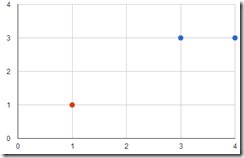如图3所示的训练数据集,其正实例点是(3,3),(3,4),负实例点是(1,1),试用感知机学习算法的原始形式求感知机模型,即求出w和b。这里,
图3
这里我们取初值,取。具体问题解释不写了,求解的方法就是算法1。
Python代码如下:
import os # An example in that book, the training set and parameters' sizes are fixed training_set = [[(3, 3), 1], [(4, 3), 1], [(1, 1), -1]] w = [0, 0] b = 0 # update parameters using stochastic gradient descent def update(item): global w, b w[0] = w[0] + 1 * item[1] * item[0][0] w[1] = w[1] + 1 * item[1] * item[0][1] b = b + 1 * item[1] # print w, b # you can uncomment this line to check the process of stochastic gradient descent # calculate the functional distance between 'item' an the dicision surface def cal(item): global w, b res = 0 for i in range(len(item[0])): res += item[0][i] * w[i] res += b res *= item[1] return res # check if the hyperplane can classify the examples correctly def check(): flag = False for item in training_set: if cal(item) <= 0: flag = True update(item) if not flag: print "RESULT: w: " + str(w) + " b: "+ str(b) os._exit(0) flag = False if __name__=="__main__": for i in range(1000): check() print "The training_set is not linear separable. "
运行结果如下:
